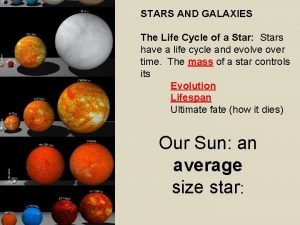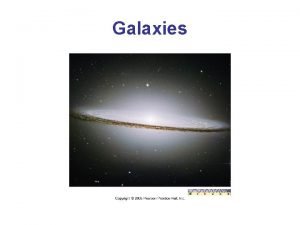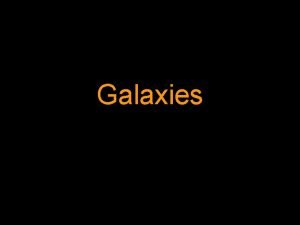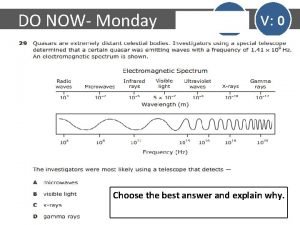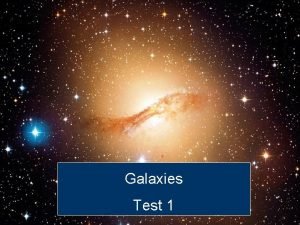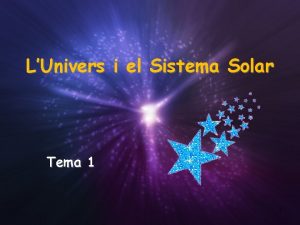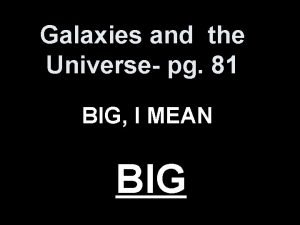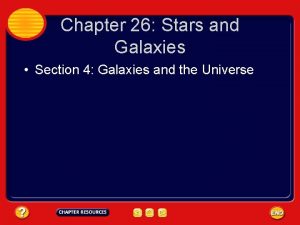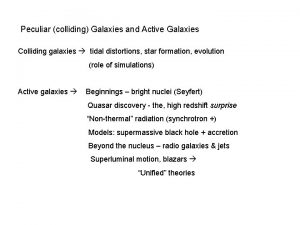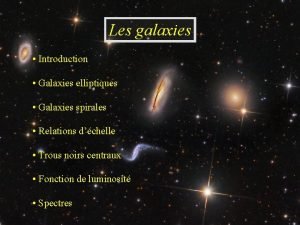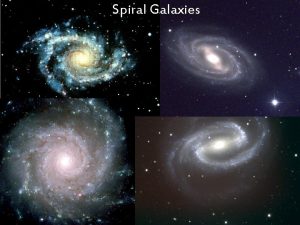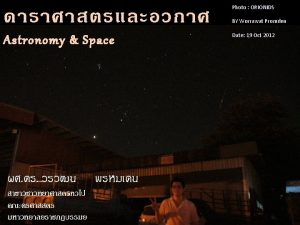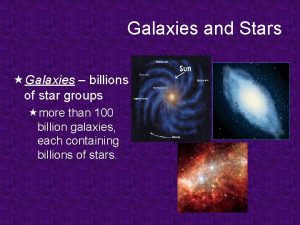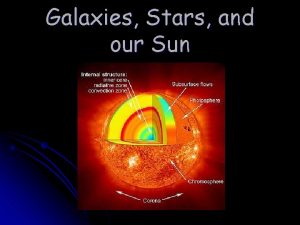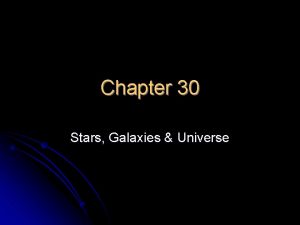Chapter 1 Stars and Galaxies l When you
















- Slides: 16

Chapter 1: Stars and Galaxies l When you look up at the sky on a clear night, you see billions of stars in the sky. Each star is actually a sun! A sun is hot sphere of glowing gas.

l Our sun is a single-star system, however most of the stars in the sky are double-star systems in which 2 stars revolve around each other. These are called binary stars.

l Constellations are groups of stars that were once believed to be imaginary people or animals. l Examples: Big Dipper, Orion, Hercules

l. A nova is when a sun suddenly increases in brightness due to a nuclear explosion. Nova’s release gas, heat, and light into space. l. A huge cloud of dust and gas where new stars are formed is called a nebula.

l. A huge collection of stars is collectively known as a galaxy. Our galaxy is named the Milky Way.

l The Big-Bang Theory states that our universe began as one large mass that exploded and gave rise to our modern-day planets. l According to this theory, all the matter and energy in the universe was once concentrated into a single place. About 15 -20 billion years ago, an explosion sent matter and energy in all directions.

l Astronomers estimate that there are more than 200 billion stars in the universe! l Stars differ in: size, mass, color, temperature, and brightness

SIZES OF STARS. . . l 1. Giant stars: 10 -100 times the size of our sun l 2. Supergiant stars: 1000 times the size l 3. White dwarf: smaller than Earth l 4. Neutron star: the smallest star

l The elements Hydrogen (H) and Helium (He) make up 96 -99% of a star’s mass.

BRIGHTNESS OF STARS. . . l Apparent Magnitude refers to the brightness of a star as it appears on Earth. l Absolute Magnitude refers to the actual amount of light that a star gives off.

THE SUN. . . l Our sun is 150 million kilometers from the Earth. It is an averagesized star, about 4. 6 billion years old. l The sun’s volume is 1 million times the size of Earth!


LAYERS OF THE SUN. . . l. Corona: outermost layer of the sun’s atmosphere, 1. 7 million degrees Celsius! (white halo) l. Chromosphere: beneath Corona, average temp. of 27, 800 C (middle layer of the Sun’s atmosphere) l. Photosphere: referred to as the sun’s surface, temp. of 6000 C l. Core: innermost part, up to 15 million degrees C, site of nuclear fusion (H + H He)

l Solar Flare: a “storm” on the sun, temperature increases, large amounts of energy are released. l Sunspots: dark spots that are seen on the sun’s surface, cooler than the rest of the sun.

SUPERNOVA. . . l When the nuclear fusion reaction is finished, the sun explodes in a tremendous release of energy called a Supernova. When this happens, temperatures of 1 billion degrees C are released!

BLACK HOLES. . . l After a star burns out, or supernovas, a core where the star used to be remains. This is called a black hole. Here, gravity produced pulls matter and energy inward and eventually is swallowed.
 Edwin hubble
Edwin hubble Chapter 30 galaxies and the universe
Chapter 30 galaxies and the universe Mary daniels is a student in england
Mary daniels is a student in england How big is the galaxy
How big is the galaxy Life cycle of galaxies
Life cycle of galaxies Elliptical galaxies facts
Elliptical galaxies facts Th eirregulars
Th eirregulars The pity relation for an adiabatic expansion is
The pity relation for an adiabatic expansion is Most galaxies in the inner region of a large cluster are
Most galaxies in the inner region of a large cluster are What are galaxies
What are galaxies Brainpop galaxies quiz answers
Brainpop galaxies quiz answers 4 types of galaxies
4 types of galaxies How are active galaxies classified?
How are active galaxies classified? Tipus de galaxies
Tipus de galaxies Type of galaxy
Type of galaxy Evolution of galaxies
Evolution of galaxies Universe pg
Universe pg




